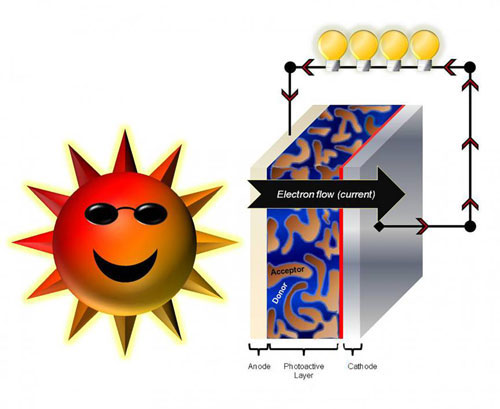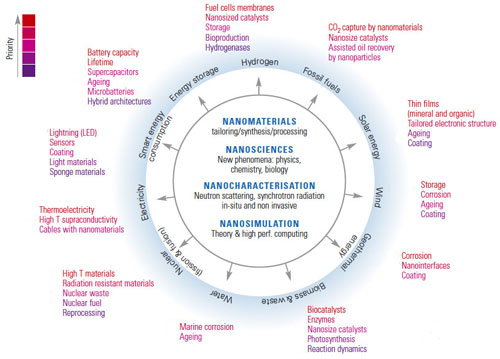| Posted: Jul 23, 2015 | |
Nanotechnology and energy - a path to a sustainable future |
|
| (Nanowerk Spotlight) During 2002 and 2003, Nobel laureate Richard E. Smalley developed a list of the Top Ten Problems Facing Humanity over the next 50 years. The Richard E. Smalley Institute for Nanoscale Science and Technology at Rice University (which in May 2015 has been merged with the Rice Quantum Institute into a new entity: the Smalley-Curl Institute) has identified 5 of these problems as society's Grand Challenges – and energy tops the list. Since then, researchers around the world have demonstrated the potential for nanotechnology to be a key technology on the path to a sustainable energy future. | |
| Against the double-whammy backdrop of an energy challenge – the world's appetite for energy keeps growing1 – plus a climate challenge – climate goals (2°C target) require substantial reduction in greenhouse gases (see: Climate change: Action, trends and implications for business. pdf) – it is the role of innovative energy technologies to provide socially acceptable solutions through energy savings; efficiency gains; and decarbonization. | |
| Why is nanotechnology relevant here – and where will nanotechnology take us in this regard? Many effects important for energy happen at the nanoscale: In solar cells, for instance, photons can free electrons from a material, which can then flow as an electric current; the chemical reactions inside a battery or fuel cell release electrons which then move through an external circuit; or the role of catalysts in a plethora of chemical reactions. These are just a few examples where nanoscale engineering can significantly improve the efficiency of the underlying processes. | |
 |
|
| The working principle of a solar cell. (Image: University of Massachusetts Amherst) | |
Nanotechnology for sustainable development |
|
| Nanotechnologies are not tied exclusively to renewable energy technologies. While researchers are exploring ways in which nanotechnology could help us to develop energy sources, they also develop techniques to access and use fossil fuels much more efficiently. Corrosion resistant nanocoatings, nanostructured catalysts, and nanomembranes have been used in the extraction and processing of fossil fuels and in nuclear power. | |
| There is no silver bullet – nanotechnology applications for energy are extremely varied, reflecting the complexity of the energy sector, with a number of different markets along its value chain, including energy generation, transformation, distribution, storage, and usage. Nanotechnology has the potential to have a positive impact on all of these – albeit with varying effects. | |
Examples – where can nanotechnology be used in the future in the energy sector |
|
| Nanomaterials could lead to energy savings through weight reduction or through optimized function: | |
|
|
|
| Nanomaterials could improve energy generation and energy efficiencies: | |
|
|
|
| We have compiled an overview of Nanotechnology in Energy that shows how nanotechnology innovations could impact each part of the value-added chain in the energy sector – energy sources; energy conversion; energy distribution; energy storage; and energy usage. | |
 |
|
| The European GENNESYS project identified a range of nanomaterial application and requirements for future energy applications3. (click on image to enlarge) | |
| In the short term, energy nanotechnology is likely to have the greatest impact in the areas of efficiency of photovoltaics (among renewables, solar has by far the biggest global energy potential) and energy storage where it can help overcome current performance barriers and substantially improve the collection and conversion of solar energy. | |
| Nanotechnology for Solar Energy Collection and Conversion is one of the five Signature Initiatives funded by the U.S. National Nanotechnology Initiative. The goals are to enhance understanding of conversion and storage phenomena at the nanoscale, improve nanoscale characterization of electronic properties, and help enable economical nanomanufacturing of robust devices. The initiative has three major thrust areas: | |
|
|
|
| The thermodynamic limit of 80% efficiency is well beyond the capabilities of current photovoltaic technologies, whose laboratory performance currently approaches only 43% 2. Nanomaterials even make it possible to raise light yield of traditional crystalline silicon solar cells. | |
| By using cheaper, nanoscale materials than the current dominant technology (single-crystal silicon, which uses a large amount of fossil fuels for production), the cost of solar cells could be brought down. | |
| Numerous research labs are working on nanotechnology-enabled batteries to increase their efficiencies for electric vehicles, home, or grid storage systems. Improving the efficiency/storage capacity of batteries and supercapacitors with nanomaterials will have a substantial economical impact. Graphene has already been demonstrated to have many promising applications in energy-related areas. (read more: "Graphene materials for energy storage applications"). | |
| Nanotechnology also has the potential to deliver the next generation lithium-ion batteries with improved performance, durability and safety at an acceptable cost ("The promise of nanotechnology for the next generation of lithium-ion batteries"). | |
| A major push on basic research for energy technologies is coming from the U.S. Department of Energy, which since 2009 has invested nearly $800m as part of the Energy Frontier Research Center (EFRC) program. For example, the Joint Center for Artificial Photosynthesis (JCAP) has developed a nanowire-based design that incorporates two semiconductors to enhance absorption of light; or the Nanostructures for Electrical Energy Storage (NEES) EFRC Center has demonstrated that precise nanostructures can be constructed to test the limits of 3-D nanobatteries by designing billions of tiny batteries inside nanopores. | |
| Against the double-whammy backdrop of an energy challenge and a climate challenge it is the role of innovative energy technologies to provide socially acceptable solutions through energy savings; efficiency gains; and decarbonization. | |
| So where does that leave 'nanotechnology'? It may not be the silver bullet, but nanomaterials and nanoscale applications will have an important role to play. This might be particularly true for nanotechnology in developing countries. | |
| Notes | |
| 1) Energy demand grows by 37% to 2040 on planned policies, an average rate of growth of 1.1%. World electricity demand increases by almost 80% over the period 2012-2040. 1.6bn people still without access to electricity, thereof 950 million in sub-Saharan Africa. (Source: IEA World Energy Outlook 2014) | |
| 2) Source: NSI Solar White Paper (pdf) | |
| 3) Source: GENNESYS White paper | |
 By
Michael
Berger
– Michael is author of three books by the Royal Society of Chemistry:
Nano-Society: Pushing the Boundaries of Technology,
Nanotechnology: The Future is Tiny, and
Nanoengineering: The Skills and Tools Making Technology Invisible
Copyright ©
Nanowerk LLC
By
Michael
Berger
– Michael is author of three books by the Royal Society of Chemistry:
Nano-Society: Pushing the Boundaries of Technology,
Nanotechnology: The Future is Tiny, and
Nanoengineering: The Skills and Tools Making Technology Invisible
Copyright ©
Nanowerk LLC
|
|
|
Become a Spotlight guest author! Join our large and growing group of guest contributors. Have you just published a scientific paper or have other exciting developments to share with the nanotechnology community? Here is how to publish on nanowerk.com. |
|
